
Across Delhi, Hyderabad, and parts of Kerala, a bold new wave of political street art is emerging—graffiti in solidarity with Gaza. As the global conflict garners attention, Indian artists are turning city walls into platforms of protest and empathy.
These artworks range from powerful slogans like “Ceasefire Now” to haunting imagery of displaced families, war-torn streets, and broken olive branches. Often created overnight, these murals are meant to be immediate and raw, much like the events they reflect. Many incorporate Palestinian symbols—like the keffiyeh or the Dome of the Rock—alongside Indian cultural motifs, creating a deep emotional bridge.
This form of activism isn’t just artistic; it’s also deeply civic. For many artists, it’s about amplifying voices that are often silenced. Public art becomes a democratic medium—unfiltered, uncensored, and accessible to all.
Despite occasional political backlash or graffiti removal, the message persists. Social media has become an extension of the wall, where images of the art are shared globally, turning a small street corner into an international stage.
Through color and courage, these artists are declaring that solidarity has a place in public space—and that paint can speak louder than politics.
